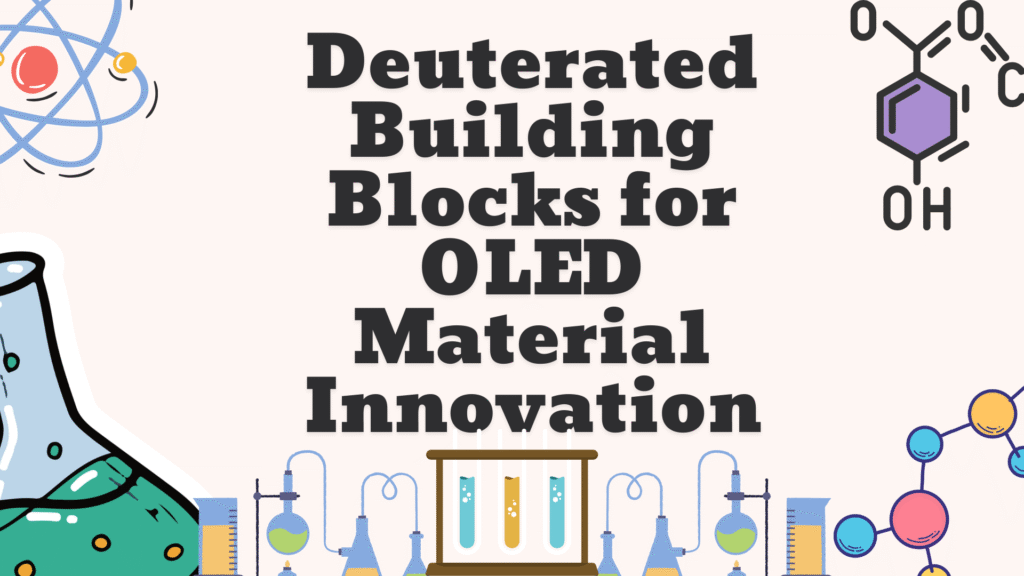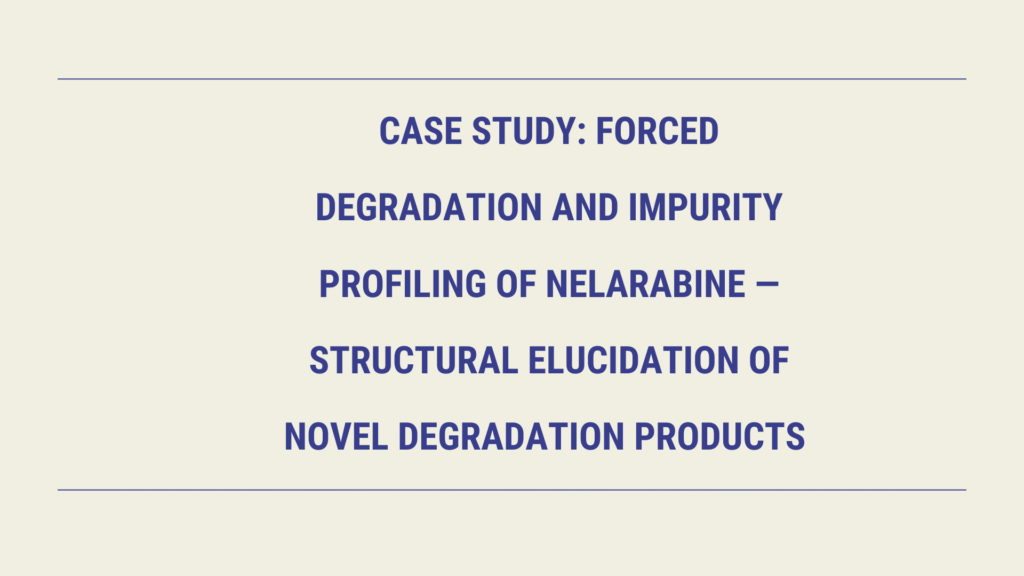
Summary: Key Insights
- Deuterated building blocks enhance OLED performance by improving stability, lifetime, and emission efficiency.
- Strategic hydrogen–deuterium substitution reduces non-radiative decay, boosting device durability.
- ResolveMass Laboratories Inc. specializes in custom synthesis of deuterated intermediates and monomers tailored for OLED applications.
- Deuteration supports vibrational energy suppression, reduced exciton quenching, and enhanced color purity in display technologies.
- Learn how custom deuterated materials are revolutionizing OLED materials and how ResolveMass leads in their synthesis and scale-up.
Introduction: How Deuterated Building Blocks Transform OLED Material Innovation
Deuterated Building Blocks are now at the forefront of OLED material innovation, enabling higher device efficiency and longer operational lifetimes.
At ResolveMass Laboratories Inc., our expertise in custom deuterium-labelled compound synthesis supports industries that demand precision isotopic control for next-generation optoelectronic materials.
These isotopically engineered compounds play a critical role in OLED emitters, hole-transport, and electron-transport layers, where even slight improvements in molecular stability translate into significant performance gains.
What Are Deuterated Building Blocks?
Deuterated Building Blocks are organic molecules in which hydrogen atoms are replaced by deuterium (²H) — a stable isotope of hydrogen. This subtle substitution enhances chemical bond strength and reduces vibrational energy losses, making materials more thermally and photochemically stable.
| Property | Hydrogen Compound | Deuterated Compound | Effect on OLED |
|---|---|---|---|
| C–H Bond Energy | ~413 kJ/mol | ~414–418 kJ/mol | Improved thermal stability |
| Vibrational Frequency | Higher | Lower | Reduced non-radiative decay |
| Isotope Effect | None | Kinetic Isotope Effect | Longer emission lifetime |
This effect is especially beneficial for OLED emitters and transport materials, where the rate of exciton annihilation and degradation can be reduced significantly.
Why Are Deuterated Building Blocks Important in OLED Development?
Deuterated building blocks are essential because they directly improve OLED performance metrics such as efficiency, color purity, and operational lifetime.
Key advantages:
- Enhanced photostability due to stronger C–D bonds.
- Reduced degradation pathways in emissive molecules.
- Lower non-radiative recombination rates, improving luminous efficiency.
- Improved color stability in blue and green OLEDs.
- Better device lifetime, crucial for display and lighting industries.
In OLED materials, hydrogen-related degradation (like bond cleavage or oxidation) is a primary failure mechanism. Substituting deuterium significantly mitigates these reactions, enabling longer-lasting devices.
How Deuteration Improves OLED Performance Mechanistically
To answer directly: deuteration suppresses non-radiative decay and oxidative degradation — two dominant causes of OLED material failure.
Mechanistic insights include:
- Kinetic isotope effect (KIE): The C–D bond vibrates more slowly, reducing molecular motion and energy loss.
- Lower vibrational quenching: Deuteration minimizes exciton–phonon coupling, sustaining luminescence.
- Enhanced oxidation resistance: C–D bonds resist radical-induced oxidation compared to C–H bonds.
- Stable excited states: Improves triplet stability in phosphorescent OLEDs (PhOLEDs).
This synergy leads to OLED devices that exhibit up to 2× longer operational lifetimes compared to non-deuterated counterparts.
Applications of Deuterated Building Blocks in OLED Materials
Deuterated building blocks find extensive use across the OLED stack architecture:
| OLED Layer | Example Compound | Function of Deuteration |
|---|---|---|
| Emitter Layer | Deuterated Ir(ppy)₃, Deuterated TADF molecules | Enhances emission stability |
| Hole Transport Layer (HTL) | Deuterated NPB or TCTA | Reduces degradation and hole-trapping |
| Electron Transport Layer (ETL) | Deuterated BPhen, Alq₃ derivatives | Improves electron mobility |
| Host Materials | Deuterated carbazoles | Provides thermal robustness |
ResolveMass Laboratories Inc. supports custom synthesis of each class of deuterated OLED building blocks — from aromatic amines, carbazoles, and pyridines to phosphorescent iridium complexes — with tailored isotope incorporation.
ResolveMass Expertise: Custom Synthesis of Deuterated Building Blocks
At ResolveMass Laboratories Inc., our expertise extends beyond isotopic substitution — we deliver end-to-end development from route design to analytical characterization.
Our team applies advanced isotopic labeling techniques and analytical methods to ensure >99% isotopic enrichment and regioselective labeling.
Capabilities include:
- Deuterium exchange reactions for selective substitution.
- Catalytic H/D exchange in aromatic systems.
- Deuterated monomer synthesis for OLED polymers.
- Comprehensive QC: NMR (¹H/²H), GC-MS, LC-MS, FTIR.
- Scalable synthesis from milligrams to multi-gram levels.
Learn more about our expertise in custom synthesis provider selection and AI-powered synthesis design for isotopically labelled materials.
Case Example: Deuterated Carbazoles for Blue OLED Stability
Blue OLEDs suffer from rapid degradation. Incorporating deuterated carbazole-based emitters significantly enhances device lifetime.
Observed outcomes:
- Operational lifetime (LT50) improved by ~60–100%.
- Color shift suppression after prolonged operation.
- Enhanced photostability under UV exposure.
Such materials, synthesized via custom polymer synthesis workflows, are a benchmark example of how isotope engineering translates into device-level innovation.
Deuterated Building Blocks vs Non-Deuterated Counterparts
| Parameter | Non-Deuterated | Deuterated |
|---|---|---|
| Chemical Stability | Moderate | High |
| Oxidation Resistance | Limited | Excellent |
| Emission Lifetime | Shorter | Longer |
| Device Lifetime | <10,000 hrs | >20,000 hrs |
| Manufacturing Cost | Standard | Slightly higher but ROI positive |
Thus, while deuterated building blocks have a marginally higher cost, their long-term performance benefits make them indispensable for premium OLED displays.
Integration of Deuterated Building Blocks in OLED Polymer Synthesis
In OLED polymers, deuterated monomers provide:
- Better morphological control and film uniformity.
- Lower degradation under electrical stress.
- Stable emission color even after prolonged device operation.
ResolveMass offers custom polymer synthesis and deuterated polymer development optimized for OLED research and manufacturing.
Selecting the Right CRO Partner for Deuterated OLED Materials
Choosing a CRO with proven isotope chemistry expertise ensures success in OLED innovation.
ResolveMass Laboratories Inc. stands out with its multi-disciplinary synthesis and analytical team, dedicated to precision isotope labeling.
Explore:
Conclusion: Deuterated Building Blocks – The Future of OLED Material Innovation
In conclusion, Deuterated Building Blocks are revolutionizing OLED material innovation by offering unmatched stability, efficiency, and durability.
With industry-leading expertise in deuterated compound synthesis, ResolveMass Laboratories Inc. enables global researchers and manufacturers to accelerate OLED breakthroughs through custom isotopic design and scalable synthesis solutions.
For collaboration or quotation, visit our
Contact Page
Contact ResolveMass
Reach Our Analytical Team
Top 10 FAQs: Deuterated Building Blocks for OLED Material Innovation
References:
- Geng H, Chen X, Gui J, Zhang Y, Shen Z, Qian P, Chen J, Zhang S, Wang W. Practical Synthesis of C-1 Deuterated Aldehydes Enabled by NHC Catalysis. Nat Catal. 2019;2(12):1071-1077. doi: 10.1038/s41929-019-0370-z. Epub 2019 Oct 28. PMID: 33791590; PMCID: PMC8008838.
- Dabbs, J.D., Taylor, C.C., Holdren, M.S. et al. Designing chemical systems for precision deuteration of medicinal building blocks. Nat Commun 15, 8473 (2024). https://doi.org/10.1038/s41467-024-52127-6
- Roberta Caporaso,abc Srimanta Manna,ab Sarah Zinken,ab Alexander R. Kochnev,d Evgeny R. Lukyanenko,d Alexander V. Kurkind and Andrey P. Antonchick, Radical trideuteromethylation with deuterated dimethyl sulfoxide in the synthesis of heterocycles and labelled building blocks,
Chem. Commun., 2016,52, 12486-12489, DOI
https://doi.org/10.1039/C6CC07196A
The Role of Extractables and Leachables (E&L) in Carcinogenicity Risk
Introduction Extractables and Leachables Carcinogenicity Testing plays a vital role in protecting patients who rely…
Case Study: Forced Degradation Study of Gimeracil — Discovery and Structure Elucidation of Novel Impurities
Introduction Forced degradation studies are a cornerstone of modern pharmaceutical development, enabling scientists to intentionally…
Affordable Bioanalytical Services for Start-Up Biotech: What to Expect
INTRODUCTION Affordable bioanalytical services for start-up biotech companies provide the essential analytical support needed to…
Top Bioanalytical Services for Small & Large Molecule Quantification
Introduction Bioanalytical services for small & large molecule quantification are essential for ensuring precision, sensitivity,…
Why Choose ResolveMass Laboratories for Bioanalytical Services: A Service Overview
INTRODUCTION The short answer is: clients choose ResolveMass because this ResolveMass Bioanalytical Services Overview demonstrates…
Case Study: Forced Degradation and Impurity Profiling of Nelarabine — Structural Elucidation of Novel Degradation Products
Introduction: The Critical Role of Forced Degradation in Defining Nelarabine Stability Forced degradation testing continues…







